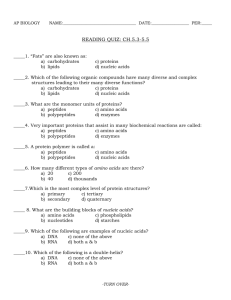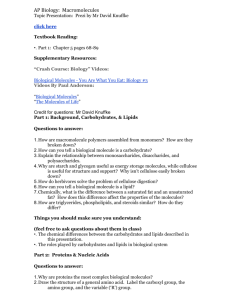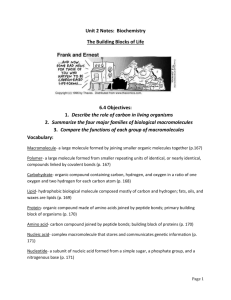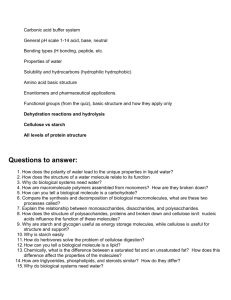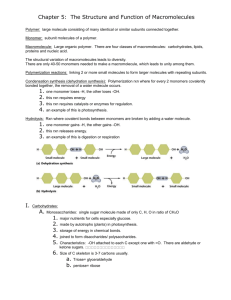BIOLOGY Heteropolymers in the cells of living organisms are
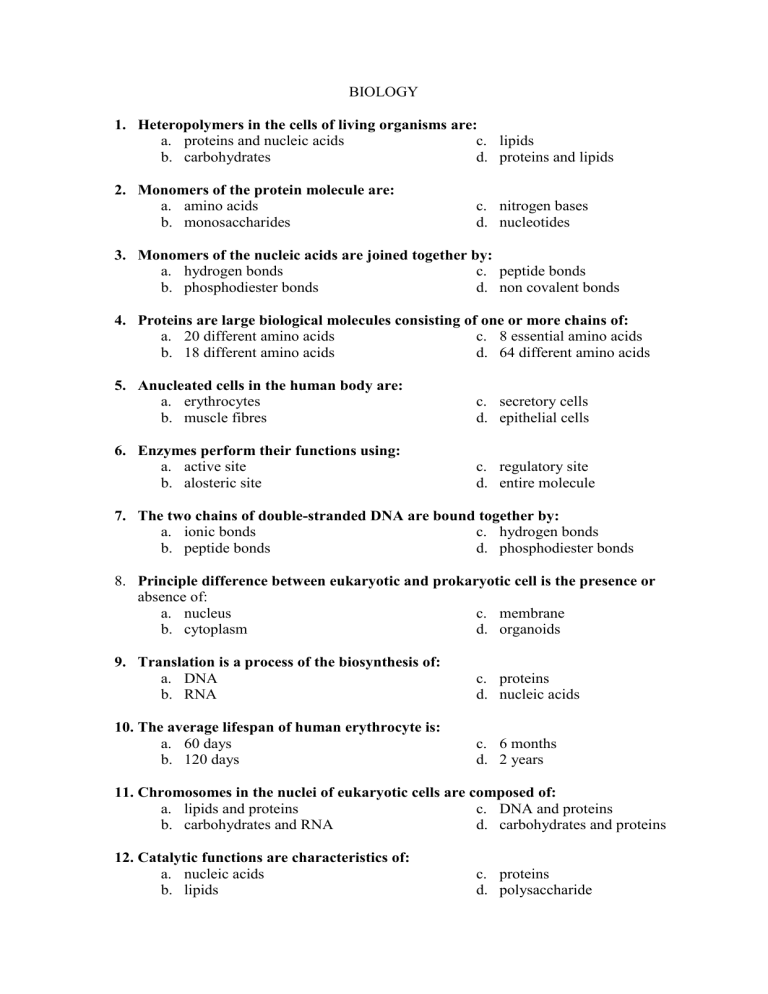
BIOLOGY
1.
Heteropolymers in the cells of living organisms are: a.
proteins and nucleic acids b.
carbohydrates c.
lipids d.
proteins and lipids
2.
Monomers of the protein molecule are: a.
amino acids b.
monosaccharides c.
d.
nitrogen bases nucleotides
3.
Monomers of the nucleic acids are joined together by: a.
hydrogen bonds c.
peptide bonds d.
non covalent bonds b.
phosphodiester bonds
4.
Proteins are large biological molecules consisting of one or more chains of: a.
20 different amino acids c.
8 essential amino acids d.
64 different amino acids b.
18 different amino acids
5.
Anucleated cells in the human body are: a.
erythrocytes b.
muscle fibres
6.
Enzymes perform their functions using: a.
b.
active site alosteric site c.
d.
secretory cells epithelial cells c.
regulatory site d.
entire molecule
7.
The two chains of double-stranded DNA are bound together by: a.
ionic bonds c.
hydrogen bonds b.
peptide bonds d.
phosphodiester bonds
8.
Principle difference between eukaryotic and prokaryotic cell is the presence or absence of: a.
nucleus c.
membrane d.
organoids b.
cytoplasm
9.
Translation is a process of the biosynthesis of: a.
DNA b.
RNA c.
d.
proteins nucleic acids
10.
The average lifespan of human erythrocyte is: a.
b.
60 days
120 days c.
6 months d.
2 years
11.
Chromosomes in the nuclei of eukaryotic cells are composed of: a.
lipids and proteins c.
DNA and proteins d.
carbohydrates and proteins b.
carbohydrates and RNA
12.
Catalytic functions are characteristics of: a.
nucleic acids b.
lipids c.
d.
proteins polysaccharide
13.
Basic structural and functional unit of organisms is: a.
cell c.
organ d.
body system b.
tissue
14.
Part of DNA molecule that codes for a polypeptide or for an RNA chain is called: a.
genome c.
phenotype d.
gene b.
genotype
15.
In case of complementary base pairing: a.
adenine binds with guanine b.
adenine binds with cytosine c.
d.
thymine binds with adenine guanine binds with thymine
16.
RNA synthesis is known as: a.
b.
transcription translation c.
denaturation d.
replication
17.
Which of the following functions is not characteristic for the proteins: a.
protective c.
catalytic d.
structural b.
secretory
18.
Proteins with catalytic functions are called: a.
liposomes b.
antibodies
19.
Tissues are groups of: a.
cells that have a common origin, similar structure and b.
function; cells that have a common origin but differ in structure and function; c.
d.
c.
enzymes antigens cells differing in origin, structure and function; d.
cells differing in origin but have similar structure and function
20.
Large organelles containing chromosomes are called: a.
nuclei b.
chromatids c.
nucleoli d.
lysosomes
21.
Mitotic division is typical for: a.
all eukaryotic somatic cells; b.
all prokaryotic cells; c.
d.
all viruses; all bacteriophages
22.
Proteins with protective function are: a.
albumins; b.
antigens; c.
d.
myosins; antibodies
23.
The components of a nucleotide are: a.
nitrogenous base and fivecarbon sugar; b.
nitrogenous base and phosphate group; c.
large nitrogenous bases and phosphate group; d.
nitrogenous base, fivecarbon sugar, phosphate group
24.
Red blood cells contain: a.
myoglobin; b.
albumin;
25.
Blood Serum differs from blood plasma in that: a.
Contains fibrinogen; b.
Does not contain fibrinogen; c.
d.
fibrinogen; hemoglobin.
c.
Contains albumin; d.
Does not contain albumi






